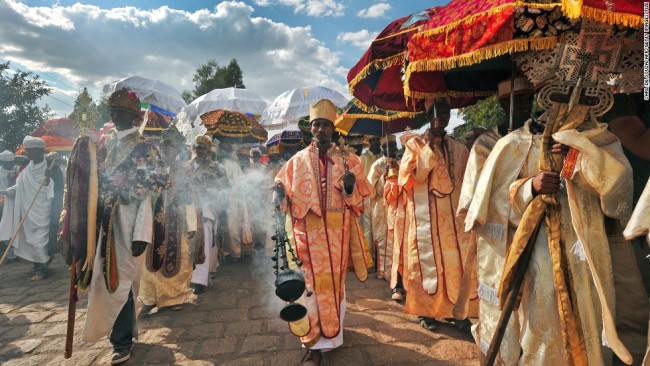Many Orthodox churches around the world celebrate Christmas on 7 January rather than 25 December. It is a good time to reflect on the plight on Orthodox communities around the world and their achievements.
One such community that is little talked about is the Ethiopian Orthodox community.
Ethiopia has a proud history of civilisation which dates back thousands of years. Christianity in the form of Coptic Orthodox was declared the official religion in AD330 and is still the religion of two-thirds of the population of around 90 million. Yet it is rarely talked about or discussed either in Greece or in Australia.
When we were there we visited the famous rock-hewn churches of Lalibela, constructed during the reign of King Gebre Mesqel Lalibela in the late 12th century. These 11 churches were chiselled out of solid rock and each stand as one monolithic piece of rock, if you can imagine such a thing.
There were many Greek religious pilgrimages organised from Greece to Ethiopia during this time and the relationship between the Greek Orthodox Church and Ethiopian churches is long-standing.
Australia too has had a long relationship with Ethiopia. Australian eucalyptus trees were brought to Ethiopia in the 1890s by Emperor Menelik II to try to reforest areas devastated by tree clearing, and today form large forests that provide timber and prevent erosion. Australia has also had a significant foreign aid commitment to Ethiopia and is a donor to maternal, neonatal and child health as well as targeted education programs. The Hamlin Fistula Hospital and the Fred Hollows Foundation, both set up by Australians, have had long relationships with Ethiopia, delivering much-needed medical services.
When we visited Ethiopia we were awestruck by the depth of their Orthodox faith and the churches, but mostly we were amazed by the determination of people to do something with their lives in the face of abject poverty.

One of the photos you see is of a woman called Nyala. Several times a week Nyala walks into the eucalypt forest on the outskirts of Addis Ababa and scavenges the forest floor to gather branches and bark and wrap them into a giant bundle that measures more than three metres wide and a metre thick.
Somehow she loads it onto her back and walks the six to eight kilometres to the timber merchant to sell it. Her small frame struggles with the weight and she must stop every few hundred meters.
When she arrives her load will be assessed and she will receive one to two dollars for it. When we spoke to Nyala she was stopped by the side of the road resting with her friend.
We gave them $20 each, which was more than both would earn in a month, and we were soon swamped by many other women and children wanting our help. We gave what we could and the women could not stop thanking us. But in a land where 70 per cent live below the poverty line of $2 a day and with four million orphans, the need for help was simply overwhelming.
We asked Nyala what she would do with the money and she explained that she had six children and she wanted to try to get them educated. She was trying to get enough to buy some exercise books and pencils for the start of the new year. It reminded me of some of the early struggles of our own parents.
Women like Nyala and her children benefit from Australian aid even as they struggle to buy a few books and pencils. Other children in a variety of government and NGO programs assisted by Australia also receive help.
But how could I explain to Nyala that Australia would be cutting its foreign aid contribution, which goes to programs that help people like her, by 40 per cent to improve our budget bottom line, despite the fact that most Australians earn in an hour what she earns in a month.
You don’t get what that means until you are confronted by people such as Nyala, desperate, yet proud and hopeful, who need medical help and who want to try to educate their children into a better future.
Ethiopia suffered immensely in the 1970s and 1980s through famine and regional conflicts and has been heavily reliant on foreign aid ever since. We could not help but be moved by the depth of faith amid the poverty, and the intense desire to educate their children and build a better future.
If there is such a thing as a global morality, then surely it dictates that we should help these people to improve their health and education systems and build their economy. Australia, with its latest cuts to foreign aid (which is now a third of the UN agreed target) will increasingly not be among the countries helping with development or with aid programs.
Back in Melbourne, I order an Ethiopian coffee, mindful of the fact that coffee is such a big export earner for Ethiopia. But I cannot help thinking that what I pay for my cup of coffee is equivalent to three back-breaking trips for Nyala.
Increasing foreign aid is not popular in Australia today, which is why Julie Bishop was barely criticised for her failure to defend against the savage cuts. But if there is one thing that we should press politicians to do, it is to promise to increase our foreign aid to respectable levels. This is not a question of politics or economics. This is a question of morality and humanity.
As for us of Greek Orthodox faith, we would do well to reach out to the Ethiopian Orthodox Community and to Ethiopia and offer our help in whatever way we can.
* Theo Theophanous is a former minister and political commentator.